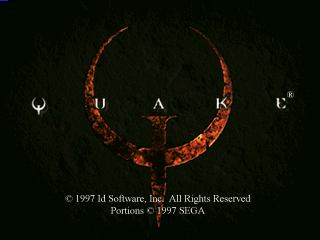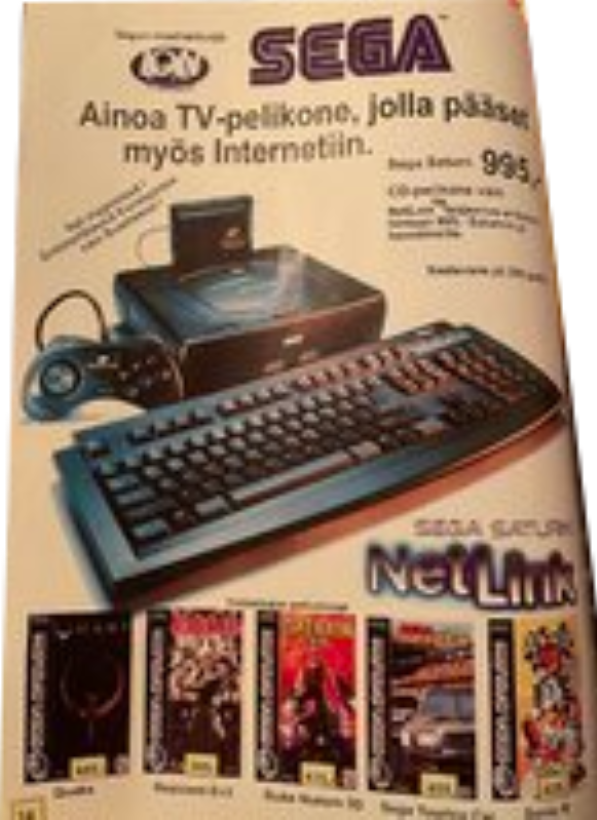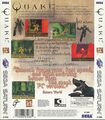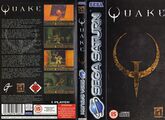Quake
From Sega Retro
- For the Sega Dreamcast tech demo, see Quake (Dreamcast).
Quake is a Sega Saturn first-person shooter game developed by Lobotomy Software and published by Sega. A port of the titular 1996 id Software game Quake, it was first released in Europe in November 1997[4], and was later brought to the United States the following month.[1]
Contents
Gameplay
Quake is a first-person shooter, and is usually credited as being the first to model everything in its world in 3D polygons, rather than the "2.5D" nature such as id Software's previous release of Doom and rival 3D Realms' Duke Nukem 3D. Quake allows the user to freely look up and down, and is capable of more elaborate scenery than its predecessors, with rooms on top of rooms and real-time lighting effects. Its original PC release was also more modifyable and made advances in networking than its predecessors, though neither feature in the Saturn conversion.
In Quake the player (unnamed in this version) has to collect four magic runes to gain access to and destroy Shub-Niggurath. There are 38 levels, most of which are spread across four "episodes" (with others such as the introduction stage and the final level being classed as levels internally, but do not included in episodes), four of which are secret levels. Like other first person shooters of the day, the task is to get to the end of a level by shooting enemies, collecting keys, solving puzzles and overcoming platforming segments.
Weapons
| Axe | |
|---|---|
| Shotgun | |
| Double-Barreled Shotgun | |
| Nailgun | |
| Super Nailgun | |
| Grenade Launcher | |
| Rocket Launcher | |
| Shotgun | |
| Thunderbolt | |
Items
Weapon powerups (ammo)
| Shells | |
|---|---|
| Ammo for shotguns and double-barreled shotguns. Small box holds 20 rounds, large holds 40. | |
| Nails | |
| Ammo for nailguns and super nailguns. Small box holds 25 nails, large holds 50. In original PC game, each nail box had the logo of Nine Inch Nails, the band behind the game's soundtrack. This was removed in the Saturn version. | |
| Rockets | |
| Ammo for grenade and rocket launchers. Small box holds 5 rockets, large holds 10. | |
| Cells | |
| Ammo for the Thunderbolt. Small box holds 6 charges, large holds 12. |
Health and armor
| 15 health | |
|---|---|
| 25 health | |
| Megahealth | |
| Green armor | |
| Yellow armor | |
| Red armor | |
Powerups
| Biosuit | |
|---|---|
| Ring of Shadows | |
| Pentagram of Protection | |
| Quad Damage | |
| Quadruples the damage of weapons for a short period. Quad Damage, its blue or purple hue and distinctive sound effect has become a staple of the Quake series, and later found its way into the 2016 release of Doom. |
Enemies
| Grunt | |
|---|---|
| Rotweiler | |
| Ogre | |
| Enforcer | |
| Knight | |
| Scrag | |
| Fiend | |
| Death Knight | |
| Zombie | |
| Vore | |
| Shambler | |
| Spawn | |
| Rotfish | |
| Chthon | |
| Shub-Niggurath | |
Levels
Episode 1: Dimension of the Doomed
Episode 2: The Realm of Black Magic
Episode 3: The Netherworld
Episode 4: The Elder World
History
id Software's original PC version of the game was inspired by Virtua Fighter, according to John Romero.
Legacy
The sequel, Quake II, was not brought to any Sega system, but was ported to the competing N64 and PlayStation. The third part of the series, Quake III Arena, was released for the Sega Dreamcast in 2000.
The original Quake was ported to the Dreamcast by Titanium Studios in just nine days, but this was a proof of concept in order to attract publishers, rather than a release set for retail[6].
Versions
Platform Differences
The Saturn version of Quake was handled by Lobotomy Software. Rather than running on the Quake engine like other ports, Lobotomy chose to use their own custom made 3D engine made specifically for the Saturn labeled "Slave Driver". This is also the engine used in other PC-to-Saturn ports such as PowerSlave/Exhumed and Duke Nukem 3D, though Quake is the only game to use fully 3D objects and enemies.
The Saturn port has four exclusive levels named "Purgatorium", "Hell's Aerie", "The Coliseum" and "Watery Grave" replacing original secret levels. The 3D Control Pad can also be used for more precise control. There is no multiplayer mode of any kind in this version. Predictably the Saturn hardware restricts the screen resolution to 320x240 and makes cuts in both polygon counts and texture sizes. Walls were added to guarantee less geometry is rendered in certain sections, causing minor adjustments to the level design. Weapons models that player holds were made 2D, leading to curious effects such as lighting from lighting gun always appearing of same lenght and super shotgun showing muzzle flash twice per shot.
However, thanks to "Slave Drive" engine, Saturn version makes use of colored lighting, which wasn't supported in original PC release. It was feature that would often be brought up when promoting the game. PC release would later get official OpenGL source port, which, while technically supported colored lighting, replaced all dynamic lighting with orange transperent "ball of light" on default configuration.
Curiously under the ESRB system for North America, the Saturn version of the game is the only version to have received a "T" as opposed to "M".
The announcement and subsequent release of a Saturn version of Quake was something of a coup amongst the console's fans, as while a PlayStation version was at one point planned, the conversion was never finished. A Nintendo 64 version was released in the months which followed, but while this version is considered to be the more playable (and more accurate) of the two, it features slightly fewer levels due to cartridge space restrictions.
Regional Differences
US version of a game appears to be improved over EU release, as it was released later. It had some bugs fixed, as well as additional minor changes were implented. Examples are: the looping sound of when the bridge to silver key is done moving in E1M2 (Episode 1 - Map 2) was fixed and rain effect was added to the "Purgatorium" secret level of the first episode.
Input combinations for activating cheats are different between these versions. US codes are the ones that are widely known, while EU version of a game either has less cheats implented or not every combination is known right now.
Credits scenes are different as well. EU version's credits show main character's apartment flat, while Intermission music plays. It's a new addition to Saturn port as well, PC original didn't have any credits scenes. US version in meanwhile had apartment flat scene moved to secret ending, accessable by cheat code, while credits at normal ending shows main hall of E1M2 instead. Both endings play a new music track found only in this version, which is credited as well.
Production credits
- Senior Producer: Stephen "Sgt. Roc" Hutchins
- Associate Producer: Michael S. Jablonn
- Product Manager: Andrew Stein
- Product Specialist: Mark Subotnick
- Lead Testers: Sean Doidge, Michael McCollum
- Assistant Lead Tester: Ferdiand Villar
- Packaging: Bob Schonfisch, Scott Allen
- Manual: Curtis Clarkson and Verdoni Multi Media
- SOA Test Department: Robert Amirkhan, Nic Azizian, Mike Callahan, The Derminator, Arnold Feener, Rick Greer, Aaron Hommes, Jeff Junio, Jean-Claude Lefebvre, Marcus Montogomery, Abe Navarro
- Dank & Scuz:
- Original concept & execution by: Michael Houston
- Sega-ized by: Ben "Biffo" Fisher, David Locke, Greg "Sparky" Winslow
- Voices:
- Dank: J.S.Gilbert
- Scuz: Matt Mark
- Misc: David Locke
- Production: Fat Box
- Original Music: Trent Reznor
- Additional Music:
- "B7" by: SONIC MAYHEM
- Producer: Sascha "Buzzfink" Dickiyan
- Co\Producer: David Valencia
- "Method of Destruction" CD available from http://www.sonicmayhem.com
- Special Thanks: John Carmack, Barrett Alexander, Todd Hollenshead and all from id who made this project possible, Chris "Applejack" Coffin for the wisdom, Geraldine Dessimoz, Marcelyn Ditter, Lydia Gable, Paul Lange of Lobotomy, Mark Lindstrom, Jaqui Lyons, Mike Markey, Anne Moellering, Judie Nybo, Heather Ravenberg, Eileen Sacman, Undyne Stafford, Dan Stevens, Bernard Stolar, Shuji Utsumi, the Cave server, Ritual, Blue's News, the world-famous SEEDY Crew and gib-fans everywhere
- Executive Producers: Paul Lange, Brian McNeely
- Project Manager: Mark Coates
- Game Re-Design: Mark Coates, Paul Knutzen
- Level Design: Paul Knutzen
- Programming Lead: Paul Haugerud
- Programming Team: Paul Haugerud, Paul Schreiber, Ezra Dreisbach
- 2D/3D Artists: Kevin Chung, Eric Klokstad
- 3D Engine: Ezra Dreisbach
- Sound Effects Editing: Scott Branston
- Development Tools: David Lawson (BREW), Paul Schreiber (PeepShow), John Yuill (YuillSoftener)
- Quality Assurance: Tom Kristensen
- Additional Programming: Patrick Schreiber, John Yuill
- Additional Art: John Van Deusen
- Additional Level Re-Design: Eric Klokstad, Mark Coates, Kevin Chung, Scott Branston
- 3D Graphic/Animation Consultants: Puddletown Graphics
- Special Thanks To: Marjacq Micro Ltd., Mark Maslowicz, Dan Jevons, Manny Granillo, Richard Leadbetter, Lloyd 'Big Mac' Kinoshita, Randy Reeves, Eric Wilson
- Programming: John Carmack, Michael Abrash, John Cash
- Design: John Romero, Sandy Petersen, American McGee, Tim Willits
- Art: Adrian Carmack, Kevin Cloud
- Biz: Jay Wilbur, Mike Wilson, Donna Jackson
- Projects & Support: Shawn Green, Barrett Alexander
- Trent Reznor and Nine Inch Nails for Sound Effects and Music
- Dave Taylor for Original Sound Code and Unix Ports
Magazine articles
- Main article: Quake/Magazine articles.
Promotional material
also published in:
Physical scans
| Sega Retro Average | ||||||||||||||||||||||||||||||||||||||||||||||||||||||||||||||||||||||||||||||||||||||||||||||||||||||||
|---|---|---|---|---|---|---|---|---|---|---|---|---|---|---|---|---|---|---|---|---|---|---|---|---|---|---|---|---|---|---|---|---|---|---|---|---|---|---|---|---|---|---|---|---|---|---|---|---|---|---|---|---|---|---|---|---|---|---|---|---|---|---|---|---|---|---|---|---|---|---|---|---|---|---|---|---|---|---|---|---|---|---|---|---|---|---|---|---|---|---|---|---|---|---|---|---|---|---|---|---|---|---|---|---|
|
| 83 | |
|---|---|
| Based on 20 reviews | |
Technical information
- Main article: Quake/Technical information.
References
- ↑ 1.0 1.1 http://riehlspot.simplenet.com/vgame/new/saturn.html (Wayback Machine: 1999-02-21 17:22)
- ↑ http://www.sega-europe.com/saturn/satinfo.html (Wayback Machine: 1998-12-02 14:09)
- ↑ Computer Trade Weekly, "" (UK; 1997-11-24), page 36
- ↑ 4.0 4.1 4.2 Computer & Video Games, "December 1997" (UK; 1997-11-12), page 108
- ↑ http://centromail.es:80/nuevo/consolas/sat.asp (Wayback Machine: 1998-01-20 17:10)
- ↑ DC-UK, "August 2000" (UK; 2000-07-06), page 45
- ↑ File:Quake sat us manual.pdf, page 18
- ↑ Świat Gier Komputerowych, "11/1997" (PL; 1997-xx-xx), page 40
- ↑ Gry Komputerowe, "12/1997" (PL; 1997-xx-xx), page 12
- ↑ Świat Gier Komputerowych, "12/1997" (PL; 1997-xx-xx), page 24
- ↑ Neo, "Grudzień 1997" (PL; 1997-xx-xx), page 2
- ↑ Świat Gier Komputerowych, "1/1998" (PL; 1997-xx-xx), page 80
- ↑ Secret Service, "Styczeń 1998" (PL; 1998-xx-xx), page 14
- ↑ Secret Service, "Luty 1998" (PL; 1998-xx-xx), page 22
- ↑ Neo, "Kwiecień 1998" (PL; 1998-xx-xx), page 4
- ↑ Neo, "Maj 1998" (PL; 1998-xx-xx), page 4
- ↑ Consoles +, "Novembre 1997" (FR; 1997-1x-xx), page 114
- ↑ Digitiser (UK) (1997-11-28)
- ↑ Edge, "Christmas 1997" (UK; 1997-11-27), page 111
- ↑ Electronic Gaming Monthly, "February 1998" (US; 1998-0x-xx), page 109
- ↑ GameFan, "Volume 5, Issue 12: December 1997" (US; 1997-xx-xx), page 26
- ↑ GamePro, "February 1998" (US; 199x-xx-xx), page 98
- ↑ GamesMaster, "Christmas 1997" (UK; 1997-11-24), page 30
- ↑ Game Informer, "January 1998" (US; 199x-xx-xx), page 60
- ↑ Gry Komputerowe, "3/1998" (PL; 1998-xx-xx), page 1
- ↑ Hobby Consolas, "Diciembre 1997" (ES; 1997-xx-xx), page 110
- ↑ L'essential des Achats pour Consoles, "Vol. 1" (FR; 1998-11-25), page 75
- ↑ Level, "4/98" (TR; 1998-xx-xx), page 1
- ↑ Mega Console, "Dicembre 1997" (IT; 1997-xx-xx), page 60
- ↑ Mega Force, "Novembre/Décembre 1997" (FR; 1997-1x-xx), page 46
- ↑ Neo, "Luty 1998" (PL; 1998-xx-xx), page 39
- ↑ Next Generation, "February 1998" (US; 1998-01-20), page 116
- ↑ Saturn Power, "Christmas 1997" (UK; 1997-11-10), page 68
- ↑ Sega Saturn Magazine, "December 1997" (UK; 1997-11-12), page 74
- ↑ Super Power, "2 1998" (FI; 1998-0x-xx), page 36
| Quake | |
|---|---|
|
Main page | Comparisons | Hidden content | Magazine articles | Video coverage | Reception | Technical information
Prototypes: 1997-10-31
| |
- 3D Control Pad-compatible games
- 1 player games
- US Saturn games
- All US games
- EU Saturn games
- All EU games
- DE Saturn games
- All DE games
- ES Saturn games
- All ES games
- PT Saturn games
- All PT games
- UK Saturn games
- All UK games
- PL Saturn games
- All PL games
- AU Saturn games
- All AU games
- BR Saturn games
- All BR games
- Saturn games
- 1997 Saturn games
- All 1997 games
- Saturn shoot-'em-up games
- All shoot-'em-up games
- All games
- Quake













